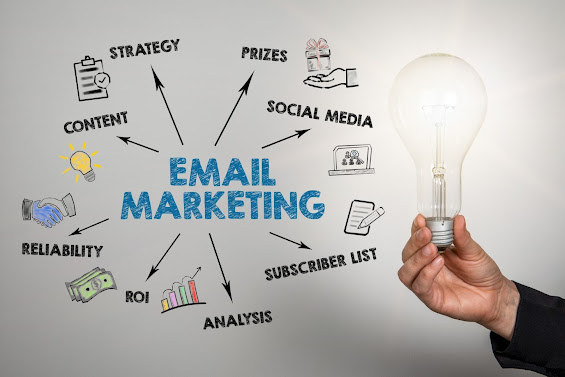The Role of Email Marketing in Digital Marketing Strategy
Introduction:
Email marketing is a powerful
tool in a digital marketer's arsenal, offering a direct and cost-effective way
to reach and engage with customers. When used strategically as part of a
comprehensive digital marketing strategy, email marketing can help businesses
drive traffic, nurture leads, build relationships, and increase sales. Here's a
detailed exploration of how email marketing can be effectively used as part of
a digital marketing strategy:
1. Building and Growing an Email List:
At the core of email marketing is
an email list comprised of subscribers who have opted in to receive
communications from your business. Building and growing an email list should be
a priority for businesses looking to leverage email marketing effectively.
Offer incentives such as discounts, freebies, or exclusive content to encourage
website visitors to subscribe to your email list. Utilize sign-up forms,
pop-ups, landing pages, and social media to capture email addresses and expand
your subscriber base.
2. Segmenting Your Email List:
Segmentation involves dividing
your email list into smaller, targeted segments based on specific criteria such
as demographics, location, interests, purchase history, or engagement level.
Segmenting your email list allows you to send more personalized and relevant
content to each segment, increasing the likelihood of engagement and
conversion. Use segmentation to tailor your messaging, offers, and
recommendations to the unique preferences and needs of each segment.
3. Creating Compelling Email Content:
The success of an email marketing
campaign hinges on the quality and relevance of the content you deliver to your
subscribers' inboxes. Create compelling email content that resonates with your
audience and provides value. This could include product updates, promotions,
educational content, industry news, blog posts, customer testimonials, and
exclusive offers. Use attention-grabbing subject lines, clear and concise copy,
compelling visuals, and persuasive calls-to-action (CTAs) to encourage opens,
clicks, and conversions.
4. Automating Email Campaigns:
Email automation allows
businesses to send targeted and personalized emails to subscribers based on
predefined triggers or actions. Automation workflows can be set up for various
purposes, such as welcome emails, abandoned cart reminders, post-purchase
follow-ups, birthday greetings, re-engagement campaigns, and drip campaigns. By
automating repetitive tasks and delivering timely, relevant messages to
subscribers, businesses can streamline their email marketing efforts and
improve efficiency.
5. Personalizing Email Communications:
Personalization is key to
creating meaningful connections with your audience and driving engagement in
email marketing. Use subscriber data and segmentation to personalize email
content, subject lines, and CTAs based on each recipient's preferences,
behavior, and past interactions with your brand. Address subscribers by name,
recommend products or content based on their interests, and tailor offers and promotions
to their purchase history or browsing behavior to create a personalized
experience that resonates with each individual.
6. Optimizing for Mobile Devices:
With the increasing prevalence of
mobile devices, it's essential to optimize email campaigns for mobile
responsiveness. Ensure that your emails are mobile-friendly and display
correctly on smartphones and tablets of all screen sizes. Use responsive design
techniques, such as single-column layouts, large fonts, and mobile-friendly
buttons, to create a seamless user experience on mobile devices. Test your
emails across different devices and email clients to ensure compatibility and
readability.
7. Analyzing and Measuring Performance:
Measuring the performance of
email marketing campaigns is essential for evaluating their effectiveness and
identifying areas for improvement. Track key metrics such as open rate,
click-through rate (CTR), conversion rate, bounce rate, unsubscribe rate, and
revenue generated from email campaigns. Use email marketing analytics tools to
analyze performance data, identify trends, and gain insights into subscriber
behavior. A/B test different elements of your emails, such as subject lines,
content, and CTAs, to optimize performance and maximize results.
8. Integrating with Other Marketing Channels:
Email marketing can be integrated
with other digital marketing channels to create a cohesive and omnichannel
marketing strategy. Coordinate email campaigns with social media, content
marketing, paid advertising, and other channels to amplify your messaging and
reach a broader audience. Use email to promote blog posts, share social media
content, announce upcoming events or webinars, and drive traffic to landing
pages or product pages. By integrating email with other marketing channels,
businesses can reinforce their messaging and create a consistent brand
experience across touchpoints.
9. Maintaining Compliance with Regulations:
It's essential for businesses to
comply with relevant regulations and guidelines when conducting email marketing
campaigns. Familiarize yourself with laws such as the CAN-SPAM Act (in the
United States) and the General Data Protection Regulation (GDPR) (in the
European Union) to ensure that your email marketing practices are legal and
ethical. Obtain explicit consent from subscribers before sending them marketing
emails, provide clear opt-out mechanisms, and honor unsubscribe requests
promptly. Maintain accurate subscriber data and secure it against unauthorized
access to protect subscribers' privacy and comply with data protection laws.
10. Continuously Testing and Optimizing:
Email marketing is an iterative
process that requires continuous testing, learning, and optimization to achieve
optimal results. Experiment with different subject lines, email formats,
content types, sending times, and frequency to identify what resonates best
with your audience. Conduct A/B tests to compare variations and determine which
elements drive higher engagement and conversions. Use insights from testing to
refine your email strategy, improve performance, and deliver greater value to
your subscribers over time.
Conclusion:
Email marketing is a versatile
and effective tool for businesses to engage with customers, drive conversions,
and build lasting relationships. By building and growing an email list,
segmenting your audience, creating compelling content, automating campaigns,
personalizing communications, optimizing for mobile devices, analyzing
performance, integrating with other channels, maintaining compliance, and
continuously testing and optimizing, businesses can leverage email marketing as
a key component of their digital marketing strategy to achieve their marketing objectives
and drive business growth.






0 Comments